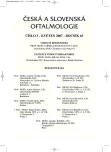The Methods of Analysis of the Endothelial Microscopy
Metody analýzy endoteliální mikroskopie
Cíl:
Porovnat výsledky klasické a digitální analýzy rohovkového endotelu.
Materiál a metody:
Hodnotili jsme soubor 36 očí s fyziologickým nálezem na předním očním segmentu, průměrný věk vyšetřovaných byl 32,8 let (SD ± 9,5). Provedli jsme vyšetření spekulárním nekontaktním mikroskopem SP 1000 TOPCON. Získaný záznam byl hodnocen i) klasickou analýzou, ii) automatickou digitální analýzou, iii) korigovanou digitální analýzou. Výsledkem klasické analýzy je buněčná hustota (počet buněk/mm² ). Digitální analýza, která je umožněna propojením spekulárního mikroskopu s počítačovým programem IMAGENET Endothelial Analysis System, hodnotí navíc koeficient variance buněčné plochy (%) a hexagonalitu (%). Normalita rozložení hodnot byla posouzena testem Liliefors, následně byl použit buď párový t-test, nebo neparametrický párový Wilcoxonův test.
Výsledky:
Srovnáním automatické a korigované digitální analýzy byl zjištěn statisticky významný rozdíl ve všech hodnocených parametrech (P = 0,01). Průměrná buněčná hustota vypočítaná klasickou analýzou (2643 ± 347) je o 3 % menší, než hodnota zjištěná korigovanou digitální analýzou (2718 ± 330 buněk/ mm² ). Přesto nebyl prokázán mezi klasickou a korigovanou digitální analýzou statisticky významný rozdíl na 1% hladině významnosti. Ve 13 případech ukázala korigovaná analýza nižší hodnoty než klasická, zatímco ve 23 případech se objevilo nadhodnocení korigovanou analýzou až o 501 buněk/mm² . Provedení klasické analýzy nebo automatické digitální analýzy endotelu jednoho oka vyžaduje v průměru 7–8 min. Doba vyšetření jednoho endotelu při použití digitální analýzy byla ve sledovaném souboru 25–30 min.
Závěr:
Přestože není mezi korigovanou digitální analýzou a klasickou analýzou endotelu statisticky významný rozdíl (P = 0,01) a mezi oběma metodami je statisticky významná závislost (r = 0,82), je nutné vzít v úvahu jejich neúplnou kompatibilitu při interpretaci výsledků u konkrétních pacientů. Korigovaná digitální analýza je sice časově náročnější, ale poskytuje více informací o stavu endoteliální monovrstvy.
Klíčová slova:
endotel, spekulární mikroskopie, buněčná hustota, hexagonalita, koeficient variance
Authors:
V. Loukotová; Z. Hlinomazová; M. Horáčková; E. Vlková
Authors‘ workplace:
Oční klinika LF MU, FN Brno
přednosta prof. MUDr. E. Vlková, CSc.
Published in:
Čes. a slov. Oftal., 63, 2007, No. 3, p. 185-192
Overview
Aim:
To compare results of classical and digital analysis of the corneal endothelium.
Material and methods:
We evaluated a group of 36 eyes with physiological findings of the anterior segment of the eye; the average age of examined persons was 32.8 years (SD ± 9.5). The examination was performed by means of non-contact specular microscope SP 1000 TOPCON. The obtained finding was evaluated by means of i) classical analysis, ii) automatic digital analysis, and iii) revised digital analysis. The result of the classical analysis is the cellular density (number of cells/mm² ). The digital analysis is made possible by means of the connection of the specular microscope with the computer program IMAGENET. The Endothelial Analysis System evaluates furthermore the coefficient of the cellular area variation (%), and the hexagonality (%). The normality of the values’ distribution was evaluated by means of the test Liliefors, subsequently the paired t-test or nonparametric Wilcoxon’s test were used.
Results:
Comparing results of the automatic to the revised digital analysis, statistically significant difference in all evaluated parameters was found (P = 0.01). The average cells’ density calculated by means of classical analysis (2643 ± 347) is by 3 % smaller than the value established by means of revised digital analysis (2718 ± 330 cells/mm² ). Regardless of that, no statistically evident difference was found at the 1 % level of significance. In 13 cases the revised digital analysis showed lower values than the classical one, whereas in 23 cases the overestimation by revised digital analysis up to 501 cells/mm² was found. To complete the classical analysis or the automatic digital analysis, it takes in average 7–8 minutes. The time needed to examine one sample of endothelium using the revised digital analysis was in the examined group 25–30 minutes.
Conclusion:
Although there is no statistically significant difference (P = 0.01) between the revised digital analysis and the classical analysis, and between both methods there is statistically significant dependence (r = 0.82); it is necessary to consider their incomplete compatibility in case of results’ interpretation in a single patient. The revised digital analysis is rather more time consuming, but supplies more information about the status of the endothelial single layer.
Key words:
endothelium, specular microscopy, cells’ density, hexagonality, coefficient of variation
Labels
OphthalmologyArticle was published in
Czech and Slovak Ophthalmology

2007 Issue 3
Most read in this issue
- Ocular Manifestations in Turner’s Syndrome
- The Methods of Analysis of the Endothelial Microscopy
- Comparison of the Two Methods, LASIK and ICL in Mild and High Hyperopia Correction – Part One
- The Contribution of the Hematological Examination in Patients with Retinal Vein Occlusio
